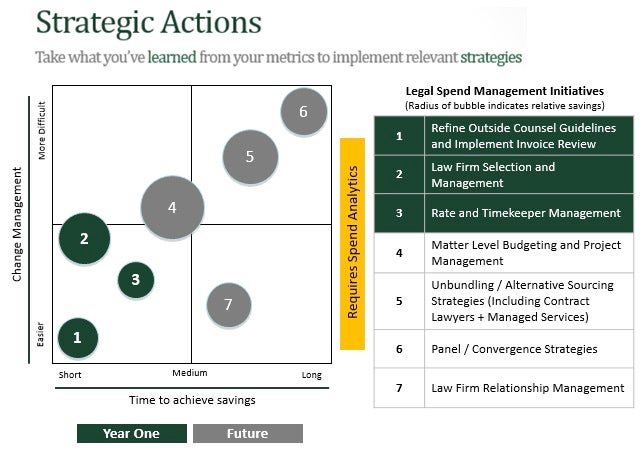
You can't manage what you can't measure. So, how do we demonstrate the value that our legal department returns to the company through improved outside counsel management? This common question is posed frequently by legal operations professionals and there are often multiple answers. When Starbucks and Elevate considered how the legal operations team could effectively communicate the value of enhanced outside counsel management, we started by asking ourselves, “what data are available and how might we best leverage those data as the basis for decision making?”
As is the case with many legal operations departments, we realized quickly that the first step on our roadmap to more effective management of outside counsel would require focus on our foundations and understanding aspects of legal spend. We recognized that there were significant insights that could be derived through a detailed assessment of our legal spend-related data.
Performing a legal spend assessment provided a low-cost solution that required minimal effort and helped us accelerate conversion of our existing spend data into relevant metrics that we could leverage in order to inform future direction — including how the legal team could operate and better leverage outside counsel.
So, what is a legal spend assessment?
A legal spend assessment is an in-depth analysis comprised of spend management recommendations, performance indicators, industry maturity benchmarks, and substantive details communicated in the form of a well-presented deck that is supported by access to the underlying data in Cael Vision, Elevate’s legal business intelligence platform.
The spend assessment provided us with heightened levels of visibility into our data and allowed our teams to have meaningful discussions about the strengths and opportunities that existed within our legal department, as it pertains to the management of legal spend.
Through a detailed analysis of trends in spending, customer concentrations, outside counsel rates, staffing models, and billing compliance, we gained full visibility into the data and were able to quickly identify existing risks, and to support our decisions to prioritize and implement new strategies.
What do you need to get started?
We understood that before we could begin to take a data-driven approach to managing outside counsel and spend, we had to better understand the underlying data. Our initial challenge was to ensure we had full visibility into a clean, comprehensive, and reliable data set. By leveraging the data we already had available through our eBilling system, we were able to quickly clean and convert those data into information and relevant metrics.
- Clean data: Assessing the quality of our legal spend data was an important first step in the process. By performing a few simple data cleansing and transformation exercises, we gained assurance that the data supporting our analysis were complete and accurate.
- Clear goals: Before setting our own goals, we considered how other organizations were managing their legal spend and what metrics they were commonly monitoring to measure their performance. Taking the time to educate ourselves on industry trends and discuss our own goals, while assessing the data, allowed us to prioritize the metrics we felt were most important to our lawyers and management team.
- Minimal time: After the data were cleansed, we went through a simple process to represent the data visually and communicate the results of the spend assessment. Within two weeks, we extracted information from our matter management system and loaded it into Cael Vision through which we could quickly generate reports for initial review. After another week, and consideration of a few additional areas of analysis, we presented the final spend assessment to the team.
What can you learn from a legal spend assessment?
Once we had gained visibility into our data and used these data to spark discussion amongst the team members, we were able to discern a lot about how we manage outside counsel to deliver legal services. A few common questions we asked were:
- Concentration of legal fees: How many law firms are we engaging to deliver legal services? Calculating the percentage of legal spend delivered by our top law firms was one simple metric to consider when discussing the potential need to contain costs through consolidation of our panel of existing law firms. And, limiting the number of new law firms being onboarded was an obvious way to reduce administrative burden.
- Staffing mix and leverage: How were our matters staffed by outside counsel? The ability to view staffing models by law firm, matter, phase, and timekeepers helped us identify potential opportunities to realign work and ensure legal services are appropriately delivered by resources with the required level of expertise.
- Rate management: How many rate increases were approved in a given period? Analysis of trending rate data, as well as comparisons of rates to historical matter details, allowed our team to benchmark an acceptable range of rate increases and determine if there is a need for enhanced control over the rate approval process. The data points resulting from the spend assessment also helped drive process improvements to eliminate the administrative burden commonly associated with communication around rate approvals.
- Timekeeper control: How many total and new timekeepers worked on our matters last year? Understanding turnover rates and the frequency with which new timekeepers were added helped our team better understand whether timekeeper control process enhancements should be considered.
- Billing compliance: Are we being billed for work that is not in compliance with our outside counsel guidelines? A high-level review of line item billing descriptions and phase or task codes helped our team identify a potential range of cost savings and justify whether a more detailed legal bill review engagement could help control legal spend.
What actions can you take after a legal spend assessment?
After we learned more from our data about the realities of our current state, we began to consider the various options for enhanced management across the spectrum of our outside counsel engagements. While there were many potential opportunities, we had to prioritize and sequence our efforts based on our goals and constraints, understanding that not every winning strategy can be implemented at once. Some areas for consideration brought to light by our legal spend assessment included:
- Additional data cleansing: Incorporation of additional data sources and focus on frequent data cleansing will provide our team with the basis for effective dashboard creation allowing us to continually monitor legal spend and key performance indicators.
- Data enrichment: In order to better track and manage legal spend, there are additional qualitative elements that could be tracked to help enrich the data. Examples of these include identification of matters with alternative fee arrangements, and tagging individual matters to track risk and complexity.
- Legal bill review: One of the easiest ways to control legal spend is through legal invoice review. By applying a process for reviewing invoices for compliance with outside counsel guidelines and billing policies, our team would be able to not only identify potential reductions and cost savings, but also gain more insight into the work being provided by our outside counsel.
- Legal operations: Identifying opportunities through analysis of our data is a great first step, but legal operations process enhancements are often required to continually execute on objectives and monitor performance against goals. Establishing and adhering to workflow for new matter intake, rate approvals, and timekeeper control are just a few areas where we could enhance our operations and drive sustained performance.
- Change management: By leveraging our clean and now readily accessible data, we have the opportunity to drive important change management initiatives such as the implementation of performance metrics and the establishment of a preferred panel of outside counsel providers. Additionally, our underlying spend data will be invaluable in supporting the law firm selection process during any future RFPs and rate negotiations, as well as managing matters against scope changes.

Why you should regularly reassess legal spend?
A legal spend assessment is only the beginning. The risks that can be identified, questions that can be answered, and opportunities for managing outside counsel that can derive from assessing spend data further highlight the need to continually monitor and enhance the information and supporting processes.
Having performed a spend assessment, we feel well equipped to measure key performance indicators and trends that will help us identify risks, proactively adjust plans and quickly respond to potential issues. We can also use the resulting data to conduct regular business reviews with our law firms and continue to enhance successful relationships.
Ultimately, the minimal time and effort invested to assess our legal spend data has significantly impacted our team’s ability to provide insights, make recommendations, and get people to the table and interested in discussing change and how legal might further demonstrate value to our company. This powerful development, substantiated and facilitated through facts and data, is why we strongly suggest corporate legal professionals to invest in a legal spend assessment.





